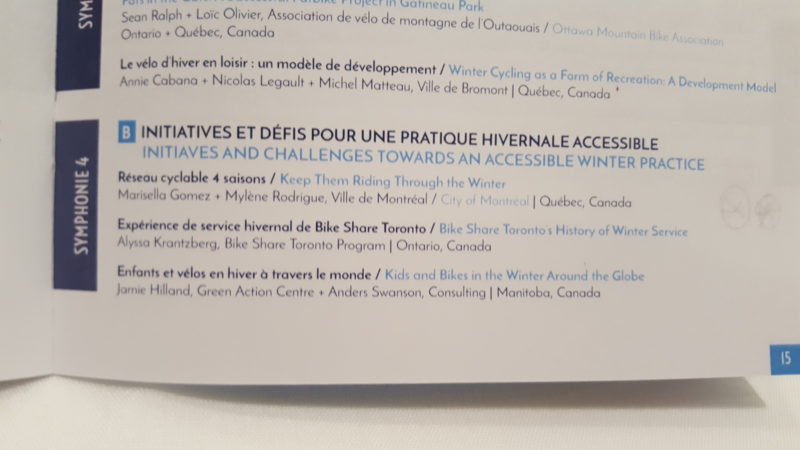
For the second year in a row, I was fortunate enough to attend the Winter Cycling Congress in Montreal from February 8th-10th. Last year’s Congress was held in Minneapolis, and really showcased what can be done in Northern cities to facilitate winter cycling, as well as the positive effects an extensive cycling network can have on getting people commuting in a healthy way. I was keen to see firsthand what one of Canada’s biggest cities does to promote safe winter cycling.
Here’s my Top Ten List of things I learnt over three packed days in Ville Marie.
- Montreal recognizes the importance of winter Cycling. Montreal Mayor Denis Coderre opened the Congress with an excellent welcoming speech, and committed his city to fully maintaining the 553+ kms of bike lanes in his City. In 2010, the city only maintained 32 kms of bike lanes in winter, increasing this to 260 kms in 2014, 348 kms in 2015, and committed to 432 in 2016. Starting in 2017, the Mayor has indicated that they want to have 100% of their bike lanes cleared all year round. He outlined how the city is seeking to ease congestion and reduce road infrastructure costs by encouraging more people to cycle all four seasons. As a long time winter cyclist, this was an encouraging announcement, and one that I am hoping others cities commit to. Winter cycling is successful in northern cities across the globe, and has a positive effect on the mental and physical health of a city’s residents, as well as lessening the wear and tear on roads.

A fully protected and maintained bike path. In winter. It can be done!
- There are many types of Winter Cycletrack maintenance. Montreal uses plows, salt and sand, seeking to have bare pavement on cycletracks in winter. Oalu, Finland uses machines that compress the snow, keeping a base layer of 1-4 cms on their paths through the winter. Residents use regular bikes without studded tires without any problem, and fat bikes are viewed as unnecessary and are extremely rare. Copenhagen plows their cycletracks FIRST before they plow the roads, as they want people to be able to walk and bike before they take to their cars. The key lesson from all of these cities was that no matter the technique, it is important to make bike lanes rideable in winter, and properly maintain them. This will result in people having confidence in their route to work or school being rideable, and choosing to bike instead of driving.
- There is a real sense of movement on a Canadian Cycling Strategy. Canada Bikes held a workshop to discuss Federal initiatives on the development of a National Cycling strategy. This workshop was held at the same time as another Pecha Kucha style workshop that conference attendees could attend, but ended up drawing close to 50 people from across Canada and the world! As Chair of the National Active and Safe Routes to School Working Group, I am part of the Active Transportation Alliance along with Canada Bikes and Canada Walks, and was greatly encouraged by the energy in the room. Folks from across the world expressed their desire for our country to promote cycling as a sustainable means of transportation, and Lars Stromgren from Sweden (his real name!) even shared Sweden’s story of developing their National Cycling strategy. Many countries in Europe have has National Cycling strategies for years, and fully developed Safe Routes to School programs. It’s time for Canada to get on board, and promote sustainable transportation for all.
- Green Action Centre has fans! Following my presentation on the Thursday am, several conference attendees stood up to ask questions, and expressed their admiration for the work on Sustainable Transportation that we are doing here at Green Action Centre. I also had several people walk up to me and introduce themselves, and express the same sentiment to me. This was inspiring to hear, as we often work in a bit of a vacuum with other professionals in the Sustainable Transportation field, so it was great to connect with people whom simply know the work we do, and are supportive of our efforts to make transportation in Canada more sustainable.
- Fatbike sales have flattened. This was a great surprise for me as my perception is that Fatbikes are the “new thing”, are hot sellers, and that it’s time to get on board. Instead, in a 2.5 hour forum on fatbiking tourism, fatbiking promotion, and fatbike trail maintenance, the presenters ended up discussing the future of fatbiking as a whole, as sales have fallen off in the last year or two. Some argued that this was simply due to the reselling of the first generation of fatbikes purchased, and that although sales of new fatbikes may be flat, there are overall more fatbike riders. Fatbike trail numbers in Vermont and Quebec are up, so there were some encouraging signs. It will be interesting to see if Fatbikes catch on beyond a niche market of users, or if they become nothing more than a fad as most people stick with regular bikes in winter. Time will tell.
- The Finns have enviable rates of Children walking and biking to school. I attended a presentation from two Active School Travel Planners from Helsinki, and was impressed at their data-on average 59% of children in Finland walk or bike to school, 18 % are bused, 10% are “other” and only 13% are driven in private vehicles. This compares to our data in Manitoba (collected from 135096 student surveys as of December 2016) that show on average only 34% of schoolchildren in Manitoba walk or bike to school, while fully 42% are driven in private vehicles, and 23% bussed. While there are many factors that contribute to these numbers, it is important to acknowledge that if we want our children in Manitoba to be able to engage in healthy school travel, we’ve got some serious work to do to almost double our rates to match the Finns.
- BikeWalkRoll continues to be a popular app! I presented on our BikeWalkRoll online app along with lead designer Anders Swanson, and we had a standing room only crowd in the room. The Q and A session was dominated by questions about our app, and we saw a corresponding spike in schools registering for the app over the last two weeks. We’re now closing in on 350 schools across the globe using the app, all done without any budget for marketing. It’s quite cool to log into the site and see schools in Russia, Spain, and Montenegro signing up. Not bad for a little app from Winnipeg!

Seeing my name in the Conference guide prompted me to quickly finish preparing my presentation…!
- Getting outside in winter is good for your Mental and Physical Health! Robin Mazumder, a PhD candidate in cognitive neuroscience at the University of Waterloo, presented on the positive mental health benefits of getting outside in winter, and how Active Transportation can greatly help with improving mental health while getting you physically healthy at the same time. He also discussed the negative effects of social isolation as we build suburbs designed for cars, without accessible public space for people to congregate. His main point was that if we want to improve the well-being of our citizens, especially in winter, we should be promoting Active Transportation. Hopefully this is a lesson that our politicians take to heart.
- There’s so much good food in Montreal. While not a “foodie” per se, I do enjoy the Winnipeg food scene immensely. On the recommendation of Foodie friends (thanks Pam Kirkpatrick!) my wife and I ate incredible food on our post conference weekend away (our first trip without kids in 14 years!?), including delicious dumplings, tasty fried chicken, and the best Caesar salad and pizza we’ve ever had. Highly recommend Magpie Pizzeria if you’re ever in Montreal.

Street Art near the St. Viateur Bagel shop. So. Good.
- Our BEST-Bike Education Program is among the best out there. There were many presentations on Bike education programs from across North America, some school based. Few were multi year, and many did not have the children riding on anything more than the schoolyard. If we want children to have the confidence to ride on roads, then we should teach them by riding on roads! As much as I wish there were bike lanes everywhere, this is not likely to happen anytime soon. We need to equip our youth with the skills and confidence to ride on roads if we actually want to have them engage in healthy, sustainable transportation.
Well, there you have it, my random top ten list from this year’s version of the Winter Cycling Congress. Next year the Congress is to be held in Moscow, Russia, so hopefully we’ll be able to attend again and learn more valuable lessons from other cities across the world on how to properly embrace winter cycling.



I got invitation one of my friend for this Winter Cycling Congress 2017 on Montreal. This Cycling Congress is really awesome event. Thanks for share this event.
Thank you Jamie, for sharing what you learned at the Winter Cycling congress. Hope to see you at Walk21 In Calgary in Sept.!